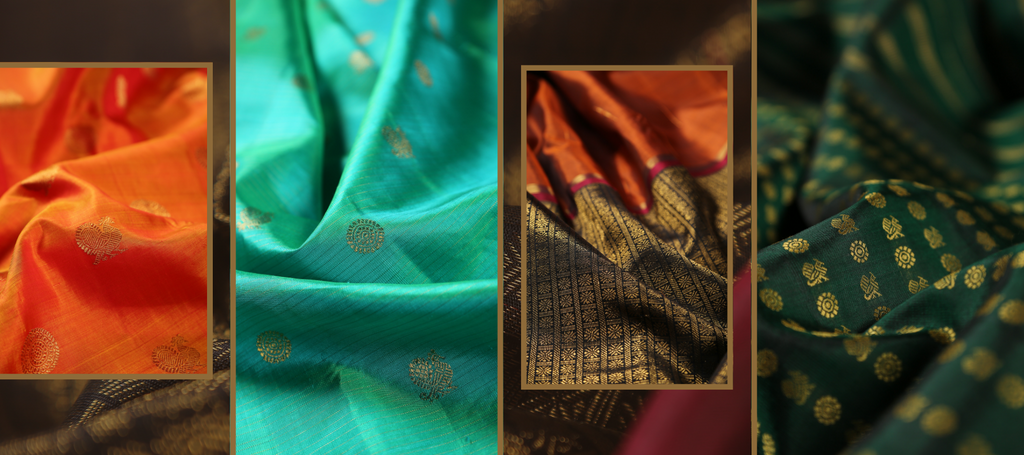Kanjeevaram Sarees are some of the most luxurious fabrics in the world; they can easily be called the queen of sarees and are some of the best items for a bridal trousseau or a heirloom. A Kanjeevaram saree is the crowning glory of every woman’s wardrobe, and they are cherished and loved and adorned with great care. The history of Kanjeevaram goes back centuries and originated in a little village called "Kanchipuram". These sarees are woven from pure silk; the weavers of a classic Kanjeevaram saree are experts and hail from families who’ve woven for centuries.
A Kanjeevaram saree often brightens up the wardrobe and is indeed worthy of the hefty price tag it comes with. While wearing a Kanjeevaram Saree is the easier part, it’s the maintenance through the decades that one needs to master. Maintaining the saree is one of the main ways to care for our possessions and bond with them. Often, our sarees hold memories and, therefore, a talisman of happiness; it’s crucial we care for them. Caring for our Kanjeevaram Sarees is also respecting and protecting an age-old tradition. Let’s take a look at some care tips for our sarees:
1. Properly fold your Kanjeevaram Saree:
We are all accustomed to folding our sarees in a particular fashion. However, a Kanjeevaram Saree is folded in a slightly different manner. A Kanjeevaram Saree often has a rich Zari border or pattern. This Zari is delicate and should be protected at all costs! The saree should be folded inwards; this ensures that the Zari maintains its sheen. The saree also appears new if folded inwards. The saree should also be folded and unfolded every few weeks, this gives the opportunity to air it out regularly, and even the saree remains crease-free.
2. We must store our sarees properly:
We must store our Kanjeevaram Sarees with great care and love. A Kanjeevaram Saree cannot be stored with other sarees, whether georgette, chiffon or cotton. A Kanjeevaram Saree should always be wrapped in a muslin cloth. A muslin cloth lets the saree breathe and protects it from outside environmental factors. If a muslin cloth is unavailable, we can go for cotton cloth. Lastly, it’s recommended to not store the saree with naphthalene balls, as it has become the trend today. Instead, air out your sarees regularly and place them with neem leaves to keep the pests at bay. Naphthalene balls and other disinfectant sprays can damage the saree or cause discoloration. Instead, you can use silica gel to key the moisture and fungus at bay and, of course, neem leaves.
3. Airing out is essential:
As mentioned briefly in the points above, a Kanjeevaram Saree should be folded every few months or weeks, this keeps any permanent creases at bay, and any musty or mouldy smell also escapes. You must also air out the saree. However, this process shouldn’t take place under direct sun. Open the saree and let it air in an open yet shaded area. You can also lay the saree on the bed and switch on the fan at a medium speed. Doing so every few months helps maintain the longevity of the saree. This is also the time to replace the old neem leaves. You must also air out the storage almirah or box and clean it thoroughly.
4. Washing and caring:
There are many blogs on the internet which recommend the washing of a Kanjeevaram Saree with a gentle shampoo. However, washing is not recommended in most cases as it can damage the saree. It’s best to be careful when wearing the saree and be wary of eatables at weddings or other events. If you’re to clean the saree, it’s best to get it professionally dry cleaned. Make sure that your dry cleaner has experience in dry cleaning exquisite pieces and understands the delicate nature of the fabric. If ironing is necessary, it should be done on the reverse side. We must also keep harsh chemicals and perfumes away from the saree. There shouldn’t be any bleaching or exposure to harsh heat and sun.
5. Avoid stacking the sarees:
Stacking the saree is common in many Indian households. However, we must avoid stacking Kanjeevaram Saree. If at all we are stacking the sarees, they should be placed in smaller stacks of three to four sarees and only two to three for heavy bridal Kanjeevaram Sarees. The position should be changed ever so often. Yet another mistake we make is suspending our sarees on hangers. Hanging the saree can spoil the Zari and the grace and fall of a Kanjeevaram. Wrapping and placing it on top of the stack is the best way to preserve a Kanjeevaram.
6. Shake the saree:
Certain Kanjeevaram Sarees can be stiff, and that’s because most weavers use starched yarn in the seasoning process. The starch falls off and softens the saree as we wear the saree. However, if you want to fasten the process, you can shake the saree just like you would do a bedsheet and wear the saree. The more you do this, the more starch will dust off, and the saree will get softer.
The care for a Kanjeevaram Sarees can seem extensive. However, it’s also one of the most rewarding experiences. A Kanjeevaram Saree has the ability to stand out in the crowd, and therefore we must care for it. The tips above are simple and reasonable; however, if your saree does develop a stain through oil or chemical, it’s best to take it to the store and consult with the sellers. They are adept at cleaning Kanjeevaram sarees and may undo the damage. At WeaverStory, each Kanjeevaram is created with extreme care and love. The sarees are authentic, and its weavers are talented and stay true to the weaving form. Kanjeevaram Saree has the ability to transform any woman into an absolute goddess, which is why we must invest in at least one piece!
Author: Uma Shekhawat








